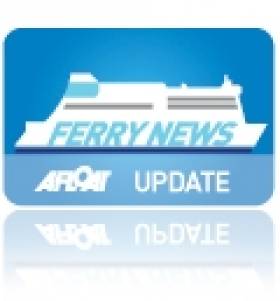Displaying items by tag: Stena Superfast V
Stena's Larger Ship for Dublin Port Route Raises Uncertainty over Future of Dun Laoghaire-Holyhead Service?
#StenaHSSfuture? – Stena Line's introduction of Stena Superfast X to expand capacity on the Dublin-Holyhead route in early 2015, raises uncertainty over the future of the Dun Laoghaire HSS operated service to Wales, writes Jehan Ashmore.
Now that Superfast X a larger passenger and freight ship of 29,500 tonnes is to make a debut in early 2015, this week's announcement comes at a time when speculation continues to mount over the re-opening in 2015 of the Dun Laoghaire-Holyhead route. In addition it raises the issue of whether the High Speed Sea-Service (HSS) Stena Explorer will return or by a smaller fast-ferry?
The route's main summer-season service ceased in September and the recent news to cancel Christmas sailings marked the first time the HSS operated route has been closed over the festive and early New Year.
Afloat.ie asked Stena to comment on the introduction of increased capacity by Superfast X on the Dublin Port route and the future viability of the Dun Laoghaire route served by the High Speed Sea-Service (HSS) Stena Explorer currently tied-up in Holyhead.
Once again the reply was a familiar response, "Stena Line is currently engaged in on-going discussions with Dun Laoghaire Harbour in relation to the provision of a seasonal fast craft service in 2015".
When Stena Superfast makes her debut in early 2015 on the core Dublin-Holyhead central corridor route, she will bring increased capacity for 1,200 passengers, notably compared to around 400 as carried by the vessel she is to directly replace, Stena Nordica.
In addition the newcomer most recently serving Dover-Calais service, is currently undergoing vehicle deck conversion work by MacGregor, the contractor which will also increase capacity to almost 2kms of lane space for cars and freight.
Plus the 'Superfast X' is having a refit to upgrade of passenger facilities in readiness for when she enters on the Dublin route. She will join the existing service's second ship, Stena Adventurer which is more of an even match compared to the 'Nordica'.
Stena Line clearly are confident in the route's potential as Dublin Port is a key strategic tourism gateway and on foot of a recovering economy. The operator citing leisure and commercial traffic between Ireland and Britain are showing really encouraging signs of future growth.
Already in service since 2011 are her sisters Superfast VII and VIII which operate on the Belfast-Cairnryan route.
As for the fuel thirsty and expensive to operate HSS Stena Explorer, the catamaran fast-ferry stood down from the Dun Laoghaire-Holyhead having operated the summer-seasonal service that began in April and ran through to early September.
This year was the HSS crafts third consecutive season of only operating a summer-only service since her introduction in 1996. The fast-ferry having then replaced the last conventional ferry to run on the Ireland-Wales link.





























































